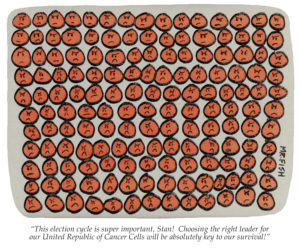Phaseout of Teflon Is Rare Win Against Chemical Companies
With manufacturers like DuPont pouring millions into campaign coffers, it is any wonder that consumer health often finishes second to corporate profits?Heather SarantisOn Jan. 25, health advocates and environmental groups celebrated a rare victory when eight chemical companies agreed to a partial phaseout of a harmful chemical used to make Teflon and other nonstick products.
The deal to reduce the use of perfluorooctanoic acid (PFOA) was the result of pressure from the U.S. Environmental Protection Agency, an extremely rare example of government muscle applied to big business in an otherwise regulation-averse Bush era. DuPont, which was fined $16 million in December for hiding evidence of PFOA’s health dangers, and seven other companies have agreed to voluntarily reduce use of PFOA in products by 95% by 2010, with a full phaseout by 2015.
Studies have linked PFOA to cancer and birth defects in animals; studies have also determined that the chemical is present in the blood of 95% of Americans, including pregnant women. The phaseout of PFOA will affect the lives of millions of Americans, eliminating or significantly reducing the amount of the chemical in countless household products including stain-resistant finishes, weatherproofing materials, waterproof clothing, phone cables and even pizza boxes and microwave-popcorn bags.
The settlement is unfortunately only a small victory for consumers, who are faced with an ever expanding list of inadequately tested chemicals in common consumer products. Less than 10% of the more than 80,000 chemicals in use nationwide have been tested for their effects on human health. In the three decades since the landmark Toxic Substances Control Act (TSCA) became law in 1976, the EPA has banned only five chemicals or chemical categories: polychlorinated biphenyls (PCB), fully halogenated chlorofluroalkanes, dioxin, asbestos (though this ban was overturned in 1991), and hexavalent chromium. The pesticide DDT, which was banned in 1972 (before TSCA was enacted), is still being found in people’s bodies today.
The settlement announcement was especially surprising in light of the Bush administration’s close ties to the chemical industry. The American Chemistry Council, the main industry lobby group, has made $21 million in campaign contributions since the beginning of the 2000 election season, $900,000 going directly to President Bush’s campaign coffers.
More predictably, the administration has broadly opposed regulation of environmental health issues and is currently trying to halt comprehensive legislation on chemical policy in Europe. In December, European health advocates suffered a serious blow when REACH — a progressive chemical policy reform bill pending in the European Parliament — was significantly watered down after heavy lobbying by the U.S. chemical industry. As secretary of state, Colin Powell did the industry’s bidding to help fight REACH, instructing diplomatic posts in Europe to oppose REACH regulation. His cable to the posts was essentially a paraphrase of industry statements opposing the legislation.
The administration is also expected to quash comprehensive policy reform in the United States. One such reform, the proposed Kid Safe Chemicals Act, is being introduced by Sens. Jim Jeffords (I-Vt.) and Frank Lautenberg (D-N.J.) and Rep. Henry Waxman (D-Calif.). The act would be the first reform of federal regulations in 30 years and would require manufacturers to provide detailed health and safety information about the chemical ingredients of consumer products and to disclose such information prior to introduction of products. The bill has attracted several high-profile co-sponsors, such as Sens. John Kerry (D-Mass.) and Hillary Rodham Clinton (D-N.Y.).
Predictably, the American Chemistry Council immediately opposed the bill, saying it duplicates existing regulations. This position ignores a Government Accountability Office report last July indicating that TSCA fails to identify health and environmental risks before chemicals are used in consumer products. As health advocates wait for the predictable GOP moves to kill the bill, they are looking elsewhere for action — to state capitals nationwide.
Last July, Maine passed the Lead Poisoning Prevention Fund, which will add a 25-cent-per-gallon tax on all paint sold. Revenues from the tax will be used to educate homeowners, renters, renovation contractors and the public about lead’s harmful health effects. And last October, after a bitter fight between environmental health advocates and cosmetic industry lobbyists, California passed the Safe Cosmetics Act of 2005, which requires cosmetic companies to report carcinogens or reproductive toxins in their products to the state Department of Health Services.
But on Jan. 19, Californians suffered a discouraging blow with the defeat of a bill in the Legislature that would have banned bisphenol-A and phthalates from products for babies and children. These chemicals, which have been linked to birth defects, cancer, early puberty onset and abnormal genital development in boys, are commonly found in plastic items such as baby bottles, teething rings, toys and numerous other products that frequently end up in children’s mouths.
The bill fell one vote short in a state Assembly Appropriations Committee vote when Leland Yee, a San Francisco Democrat who normally is a supporter of consumer rights and environmental causes, changed his vote to “no” at the last-minute.
Yee justified his switch by claiming that the scientific evidence about bisphenol-A and phthalates was inconclusive — despite a decision in December by the California Department of Environmental Health Hazard Assessment to recognize two of the phthalates listed in the bill as reproductive toxins. Environmental Health Perspectives, a peer-reviewed journal of the U.S. National Institute of Environmental Health Sciences, reported that 94 out of 115 published studies found concerns about low-dose effects of bisphenol-A. While more than 90% of government-funded studies surveyed have reported significant adverse health effects from bisphenol-A, industry-funded studies have found no significant effects.
Yee’s switch illustrates how strong the tendency is for many legislators and government officials nationwide to ignore scientific findings about chemical dangers.
Important fights are underway in other state capitals, such as these:
These state-level efforts fill in some gaps in federal regulations and help build a base of supporters for larger policy reforms. On their own, these state-level reforms will not adequately protect humans from the thousands of chemicals introduced into consumer goods and the environment each year. Perhaps the greatest value of these recent reforms, successful or failed, will be the beginning of a wide-ranging debate about public health — a debate which will hopefully cause politicians to value the health of Americans over chemical industry profits.
Your support matters…Independent journalism is under threat and overshadowed by heavily funded mainstream media.
You can help level the playing field. Become a member.
Your tax-deductible contribution keeps us digging beneath the headlines to give you thought-provoking, investigative reporting and analysis that unearths what's really happening- without compromise.
Give today to support our courageous, independent journalists.









You need to be a supporter to comment.
There are currently no responses to this article.
Be the first to respond.